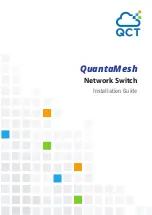
• Switch failure
• Inter-switch stacking link failure
• Switch insertion
• Switch removal
If the master switch goes off line, the standby replaces it as the new master and the switch with the next
highest priority or MAC address becomes standby.
Stack Master Election
The stack elects a master and standby unit at bootup time based on two criteria.
•
Unit priority
— User-configurable. The range is from 1 to 14. A higher value (14) means a higher
priority. The default is
1
. By removing the stack-unit priority using the
no stack-unit priority
command, you can set the priority back to the default value of zero. The unit with the highest priority
is elected the master management unit; the unit with the second highest priority is elected the
standby unit.
•
MAC address (in case of priority tie)
— The unit with the higher MAC value becomes the master unit.
The stack takes the MAC address of the master unit and retains it unless it is reloaded.
To view which switch is the stack master, enter the
show system
command. The following example
shows sample output from an established stack.
A change in the stack master occurs when:
• You power down the stack master or bring the master switch offline.
• A failover of the master switch occurs.
• You disconnect the master switch from the stack.
When a stack reloads and all the units come up at the same time; for example, when all units boot up
from flash, all units participate in the election and the master and standby are chosen based on the
priority or MAC address.
When the units do not boot up at the same time, such as when some units are powered down just after
reloading and powered up later to join the stack, they do not participate in the election process even
though the units that boot up late may have a higher priority configured. This happens because the
master and standby have already been elected, hence the unit that boots up late joins only as a member.
When an up and running standalone unit or stack is merged with another stack, based on election, the
losing stack reloads and the master unit of the winning stack becomes the master of the merged stack.
For more details, see sections
Add Units to an Existing S-Series Stack
. It is possible to reset individual units to force them to give up the management role or
reload the whole stack from the CLI to ensure a fully synchronized bootup.
Example of Viewing Stack Members
Dell#show system brief
Stack MAC : 00:01:e8:8c:53:32
Reload Type : normal-reload [Next boot : normal-reload]
-- Stack Info --
Unit UnitType Status ReqTyp CurTyp Version Ports
-----------------------------------------------------------------
0 Member not present
1 Management online S4810 S4810 4810-8-3-12-1447 64
Stacking
955
Summary of Contents for S4820T
Page 1: ...Dell Configuration Guide for the S4820T System 9 8 0 0 ...
Page 282: ...Dell 282 Control Plane Policing CoPP ...
Page 622: ...Figure 81 Configuring Interfaces for MSDP 622 Multicast Source Discovery Protocol MSDP ...
Page 623: ...Figure 82 Configuring OSPF and BGP for MSDP Multicast Source Discovery Protocol MSDP 623 ...
Page 629: ...Figure 86 MSDP Default Peer Scenario 2 Multicast Source Discovery Protocol MSDP 629 ...
Page 630: ...Figure 87 MSDP Default Peer Scenario 3 630 Multicast Source Discovery Protocol MSDP ...
Page 751: ...10 11 5 2 00 00 05 00 02 04 Member Ports Te 1 2 1 PIM Source Specific Mode PIM SSM 751 ...
Page 905: ...Figure 112 Single and Double Tag First byte TPID Match Service Provider Bridging 905 ...
Page 979: ...6 Member not present 7 Member not present Stacking 979 ...
Page 981: ...storm control Storm Control 981 ...
Page 1103: ...Figure 134 Setup OSPF and Static Routes Virtual Routing and Forwarding VRF 1103 ...
















































